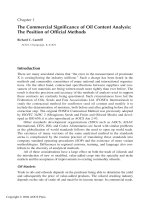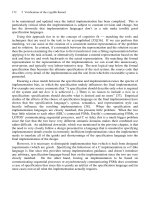Advanced Database Technology and Design phần 1 ppsx
Bạn đang xem bản rút gọn của tài liệu. Xem và tải ngay bản đầy đủ của tài liệu tại đây (670.36 KB, 56 trang )
TEAMFLY
Team-Fly
®
Advanced Database Technology and Design
This Page Intentionally Left Blank
Advanced Database Technology and Design
Mario Piattini
Oscar Díaz
Editors
Artech House
Boston London
www.artechhouse.com
Library of Congress Cataloging-in-Publication Data
Advanced database technology and design / Mario G. Piattini, Oscar Díaz, editors.
p. cm. (Artech House computing library)
Includes bibliographical references and index.
ISBN 0-89006-395-8 (alk. paper)
1. Database management. 2. Database design. I. Piattini, Mario, 1966
II. Díaz, Oscar. III. Series.
QA76.9.D3 A3435 2000
005.74dc21 00-055842
CIP
British Library Cataloguing in Publication Data
Advanced database technology and design. (Artech House computing library)
1. Databases 2. Database design
I. Piattini, Mario G. II. Díaz, Oscar
005.74
ISBN1-58053-469-4
Cover design by Igor Valdman
© 2000 ARTECH HOUSE, INC.
685 Canton Street
Norwood, MA 02062
All rights reserved. Printed and bound in the United States of America. No part of this book
may be reproduced or utilized in any form or by any means, electronic or mechanical, in-
cluding photocopying, recording, or by any information storage and retrieval system, with-
out permission in writing from the publisher.
All terms mentioned in this book that are known to be trademarks or service marks have
been appropriately capitalized. Artech House cannot attest to the accuracy of this informa-
tion. Use of a term in this book should not be regarded as affecting the validity of any trade-
mark or service mark.
International Standard Book Number: 0-89006-395-8
Library of Congress Catalog Card Number: 00-055842
10987654321
Contents
Preface xv
Part I: Fundamentals 1
1 Evolution and Trends of Database Technology 3
1.1 Introduction 3
1.2 Database Evolution 4
1.2.1 Historical Overview: First and Second DB Generations 4
1.2.2 Evolution of DB Design Methodologies 8
1.3 The New DB Generation 10
1.3.1 Problems of Current DBs 11
1.3.2 Changes in Organizations and in Computers:
The Impact on DBs 11
1.3.3 Nontraditional Applications 13
1.4 Research and Market Trends 15
1.4.1 Performance 16
1.4.2 Distribution and Integration 17
1.4.3 Functionality and Intelligence 18
1.5 Maturity of DB Technology 20
References 22
Selected Bibliography 23
v
2 An Introduction to Conceptual Modeling of
Information Systems 25
2.1 The Functions of an Information System 25
2.1.1 The Memory Function 28
2.1.2 The Informative Function 28
2.1.3 The Active Function 30
2.1.4 Examples of ISs 31
2.2 Conceptual Modeling 33
2.2.1 Conceptual Schema of the State 34
2.2.2 Information Base 38
2.2.3 Conceptual Schema of the Behavior 39
2.2.4 Integrity Constraints 43
2.2.5 Derivation Rules 45
2.3 Abstract Architecture of an IS 46
2.4 Requirements Engineering 51
2.5 Desirable Properties of Conceptual Schemas 53
References 56
Selected Bibliography 57
Part II: Advanced Technologies 59
3 Active Databases 61
3.1 Introduction 61
3.2 Example: University Database 63
3.3 Analysis 64
3.3.1 Recovering Business Policies 64
3.3.2 Causal Business Policies 67
3.4 Design 69
3.4.1 Active Rules 69
3.4.2 Supporting Recovering Business Policies Through
Active Rules 69
3.4.3 Supporting Causal Business Policies Through
Active Rules 73
3.4.4 Active Behavior 76
3.5 Implementation Issues 78
vi Advanced Database Technology and Design
3.5.1 Active Rules in Oracle 79
3.5.2 Active Rules in Use 81
3.5.3 Standardizing Active Behavior in SQL: 1999 85
3.6 Rule Maintenance 85
3.7 Summary 87
References 88
Selected Bibliography 89
4 Deductive Databases 91
4.1 Introduction 91
4.2 Basic Concepts of Deductive Databases 93
4.2.1 Definition of a Deductive Database 93
4.2.2 Semantics of Deductive Databases 96
4.2.3 Advantages Provided by Views and Integrity
Constraints 98
4.2.4 Deductive Versus Relational Databases 100
4.3 Query Processing 102
4.3.1 Bottom-Up Query Evaluation 103
4.3.2 Top-Down Query Evaluation 105
4.3.3 Magic Sets 107
4.4 Update Processing 108
4.4.1 Change Computation 109
4.4.2 View Updating 114
4.4.3 Integrity Constraint Enforcement 117
4.4.4 A Common Framework for Database Updating
Problems 119
4.5 Deductive Database System Prototypes 128
4.6 Summary 130
References 131
Selected Bibliography 136
5
Temporal Database Systems 137
5.1 Introduction 137
5.2 Temporal Data 140
5.2.1 Some Basic Concepts and Questions 142
Contents vii
5.3 Whats the Problem? 146
5.3.1 Semitemporalizing Suppliers and Parts 147
5.3.2 Fully Temporalizing Suppliers and Parts 149
5.4 Intervals 154
5.5 Interval Types 156
5.6 Scalar Operators on Intervals 159
5.7 Aggregate Operators on Intervals 160
5.8 Relational Operators Involving Intervals 162
5.9 Constraints Involving Intervals 170
5.10 Update Operators Involving Intervals 174
5.11 Database Design Considerations 176
5.11.1 Horizontal Decomposition 177
5.11.2 Vertical Decomposition 179
5.12 Further Points 181
5.13 Summary 182
References 184
Selected Bibliography 184
6
Object-Relational Database Systems 189
6.1 Introduction 189
6.2 A Quick Look at Relational and Object-Oriented
Databases 191
6.3 Contrasting the Major Features of Pure Relational
and Object-Oriented Databases 192
6.4 Drawbacks of Pure Relational and Object-Oriented
Databases 193
6.5 Technology Issues: Enabling Object Functionality
in the Relational World 195
6.5.1 Behavior 196
6.5.2 Collection Types 196
6.5.3 Encapsulation 197
6.5.4 Polymorphism 197
6.5.5 Inheritance 197
6.6 ORDBMS: A Closer Look at Characteristics in
the Physical Implementation 198
viii Advanced Database Technology and Design
6.7 Design Issues: Capturing the Essence of the
Object-Relational Paradigm 201
6.8 An Object-Relational Example 203
6.9 The ABC Corporation Example 207
6.10 Summary 208
Selected Bibliography 208
7 Object-Oriented Database Systems 211
7.1 Introduction and Motivation 211
7.2 Basic Concepts of the Object-Oriented Data Model 212
7.2.1 Objects and Object Identifiers 214
7.2.2 Aggregation 216
7.2.3 Methods 217
7.2.4 Classes and Instantiation Mechanisms 218
7.2.5 Inheritance 219
7.3 Graphical Notation and Example 220
7.4 ODMG Standard 221
7.4.1 Objects and Literals 222
7.4.2 Types: Classes and Interfaces 222
7.4.3 Subtypes and Inheritance 223
7.4.4 Extents 223
7.4.5 Keys 224
7.4.6 Collection and Structured Types 224
7.5 Technology 225
7.5.1 GemStone 225
7.5.2 ObjectStore 227
7.5.3 POET 229
7.6 Object-Oriented Database Design 230
7.6.1 Conceptual Design 232
7.6.2 Standard Schema Design 233
7.6.3 Implementation Schema Design 242
7.7 Summary 246
References 248
Selected Bibliography 249
Web Sites 250
Contents ix
8 Multimedia Database Management Systems 251
8.1 Introduction 251
8.1.1 Diverse Nature of Media Objects 251
8.1.2 Complexity and Multidimensionality 252
8.2 A Sample IMD 254
8.3 Design of an MM-DBMS for IMDs 256
8.3.1 Modeling IMDs 256
8.3.2 IMD Retrieval Issues 266
8.4 Conclusions 274
8.4.1 Main Achievements of MM-DBMS Technology 274
8.4.2 Commercial Products and Research Prototypes 280
8.4.3 Further Directions and Trends 282
References 286
Selected Bibliography 289
9
Distributed Databases 291
9.1 Introduction 291
9.2 Distributed Database Architecture 293
9.2.1 Five-Level Model for Heterogeneous Multi-DBMS 296
9.2.2 Four-Level Model for Homogeneous Multi-DBMS 298
9.2.3 Three-Level Model for Single-DBMS 298
9.2.4 Physical Database Connectivity 298
9.2.5 Distributed Data Independence 299
9.2.6 Other Decentralized Database Architectures 300
9.3 Distributed Database Design 301
9.3.1 Data Fragmentation and Replication in
Relational DDBs 301
9.3.2 Top-Down Design of Relational DDBs 304
9.3.3 Bottom-Up Design of Heterogeneous DDBs 307
9.4 Distributed Query Processing 310
9.4.1 Query Processing in Relational DDBs 310
9.4.2 Query Processing in Heterogeneous DDBs 314
9.5 Distributed Transaction Management 315
9.5.1 Distributed Concurrency Control 316
9.5.2 Distributed Commit 319
x Advanced Database Technology and Design
TEAMFLY
Team-Fly
®
9.5.3 Distributed Recovery 322
9.5.4 Transaction Management in Heterogeneous DDBs 322
9.6 Current Trends and Challenges 323
9.6.1 Alternative Transaction Models 323
9.6.2 Mediator Architectures 324
9.6.3 Databases and the World Wide Web 325
References 325
Selected Bibliography 327
10
Mobile Computing: Data Management Issues 329
10.1 Introduction 329
10.2 Motivation 331
10.3 Architecture 332
10.4 Technological Aspects: Wireless Networks 334
10.4.1 Analog Cellular Networks 334
10.4.2 Digital Cellular Networks 334
10.4.3 Wireless Wide-Area Networks 335
10.4.4 Wireless Local-Area Networks 335
10.4.5 Satellite Networks 335
10.4.6 The Future 336
10.5 Special Issues for Consideration 336
10.5.1 Mobility 336
10.5.2 Wireless Medium 336
10.5.3 Portability of Mobile Elements 337
10.6 Impact of Mobile Computing on Data Management 338
10.6.1 Transactions 338
10.6.2 Data Dissemination by Broadcasting 339
10.6.3 Query Processing 340
10.6.4 Caching 341
10.6.5 Database Interfaces 341
10.7 Communication Models and Agents 342
10.7.1 Communication Models 342
10.7.2 Agents 343
10.8 Mobile Computer Design Features for Accessing
Data Services 344
Contents xi
10.9 Summary 347
References 347
Selected Bibliography 351
11 Secure Database Systems 353
11.1 Introduction 353
11.2 Access Control: Concepts and Policies 354
11.2.1 Basic Concepts 354
11.2.2 Access Control Policies 355
11.2.3 Administration Policies 360
11.3 Discretionary Access Control Models and Systems 362
11.3.1 Authorization Models for Relational DBMSs 363
11.3.2 Authorization Models for Object DBMSs 366
11.3.3 Authorization Models for Active DBMSs 369
11.3.4 Comparative Analysis of Authorization Models 370
11.3.5 Discretionary Access Control in Commercial DBMSs 370
11.4 Multilevel Security in Database Systems 375
11.4.1 Multilevel Relational Data Model 375
11.4.2 Architectures 376
11.4.3 Prototypes 380
11.4.4 Commercial Products 384
11.4.5 Multilevel Object Data Models 387
11.5 Design Issues 392
11.6 Some Research Trends 393
11.6.1 Digital Libraries 394
11.6.2 Data Protection for Workflow Management Systems 396
11.6.3 Data Protection for the World Wide Web 397
11.7 Summary 398
References 399
Selected Bibliography 402
12
Component Database Systems 403
12.1 Introduction 403
12.2 Motivation 405
12.3 Principles of Component DBMSs 409
xii Advanced Database Technology and Design
12.3.1 DBMS Architecture 409
12.3.2 Components and DBMS Architecture 412
12.3.3 Typology of Component DBMSs 413
12.4 Component Database Models 416
12.4.1 Plug-In Components 417
12.4.2 Middleware DBMS 419
12.4.3 Service-Oriented DBMSs 422
12.4.4 Configurable DBMSs 423
12.4.5 Categories of Component DBMS Models 424
12.5 Development of Component DBMSs and Their
Applications 424
12.5.1 Database Design for CDBMSs 426
12.5.2 Development of CDBMS Components 427
12.6 Related Work: The Roots of CDBMSs 428
12.7 Summary 430
References 431
Part III: Advanced Design Issues 437
13 CASE Tools: Computer Support for Conceptual
Modeling 439
13.1 Introduction to CASE Tools 439
13.1.1 Functional Classification of CASE Tools 440
13.1.2 Communication Between CASE Tools 444
13.2 A CASE Framework for Database Design 445
13.3 Conceptual Design Tools 447
13.3.1 The Choice of the Conceptual Model 448
13.3.2 Conceptual Modeling Tools 449
13.3.3 Verification and Validation Tools 455
13.3.4 Conceptual Design by Schema Integration 463
13.3.5 Conceptual Design Based Upon Reusable
Components 467
13.3.6 Conclusion on the Conceptual Level 468
13.4 Logical Design Tools 469
13.4.1 Fundamentals of Relational Design 469
13.4.2 Functional Dependency Acquisition 470
Contents xiii
13.4.3 Mapping From Conceptual Schema to
Logical Schema 473
13.4.4 Concluding Remarks on the Logical Design 479
13.5 Summary 479
References 480
Selected Bibliography 482
14 Database Quality 485
14.1 Introduction 485
14.2 Data Model Quality 488
14.2.1 Quality Factors 490
14.2.2 Stakeholders 490
14.2.3 Quality Concepts 492
14.2.4 Improvement Strategies 493
14.2.5 Quality Metrics 493
14.2.6 Weighting 500
14.3 Data Quality 501
14.3.1 Management Issues 502
14.3.2 Design Issues 504
14.4 Summary 505
References 506
Selected Bibliography 509
About the Authors 511
Index 517
xiv Advanced Database Technology and Design
Preface
Since computers were introduced to automate organization management,
information system evolution has influenced data management considerably.
Applications demand more and more services from information stored in
computing systems. These new services impose more stringent conditions on
the currently prevailing client/server architectures and relational database
management systems (DBMSs). For the purpose of this book, those
demands can be arranged along three aspects, namely:
Enhancements on the structural side. The tabular representation of data
has proved to be suitable for applications, such as insurance and banking,
that have to process large volumes of well-formatted data. However, newer
applications such as computer-aided manufacturing or geographic informa-
tion systems have a tough job attempting to fit more elaborate structures into
flat records. Moreover, the SQL92 types are clearly insufficient to tackle
time or multimedia concerns.
Improvements on the behavioral side. Data are no longer the only aspect
to be shared. Code can, and must, be shared. DBMS providers are striving to
make their products evolve from data servers to code servers. The introduc-
tion of rules to support active and deductive capabilities and the inclusion of
user-defined data types are now part of that trend.
Architectural issues. New applications need access to heterogeneous and
distributed data, require a higher throughoutput (e.g., large number of trans-
actions in e-commerce applications), or need to share code. The client/server
architecture cannot always meet those new demands.
xv
This book aims to provide a gentle and application-oriented intro-
duction to those topics. Motivation and application-development considera-
tions, rather than state-of-the-art research, are the main focus. Examples are
extensively used in the text, and a brief selected reading section appears at the
end of each chapter for readers who want more information. Special atten-
tion is given to the design issues raised by the new trends.
The book is structured as follows:
Part I: Fundamentals
Chapter 1 gives an overview of the evolution of DBMS and how its history
has been a continuous effort to meet the increasing demands of the applica-
tions. Chapter 2 provides a gentle introduction to the key concepts of con-
ceptual modeling.
Part II: Advanced Technologies
This part presents technological and design issues that we need to face to
address new application requirements. The first two chapters deal with rule
management, Chapter 3 covers active database systems, and Chapter 4
deductive ones. Chapter 5 examines the concepts of temporal databases and
the problems of time management. Chapters 6 and 7 discuss two different
ways of introducing object orientation in database technology: the more
evolutionary one (object-relational DBMSs) and the more revolutionary one
(object-oriented DBMSs). Chapter 8 discusses the issues related to multime-
dia databases and their management. Chapters 9 and 10 present distributed
and mobile DBMSs, respectively. Chapter 11 focuses on security concerns
by discussing secure DBMSs. Chapter 12 introduces a new approach to
DBMS implementation: component DBMSs.
Part III: Advanced Design Issues
Part III looks at two topics that are necessary for obtaining databases of a cer-
tain level of quality. Chapter 13 examines various concepts associated with
computer-aided database design that claim to be an effective way to improve
database design. Chapter 14 concentrates on considering quality issues in
database design and implementation.
As for the audience, the book is targeted to senior undergraduates and
graduate students. Thus, it is mainly a textbook. However, database profes-
sional and application developers can also find a gentle introduction to these
topics and useful hints for their job. The prerequisites for understanding the
book are a basic knowledge of relational databases and software engineering.
Some knowledge of object-oriented technology and networks is desirable.
xvi Advanced Database Technology and Design
We would like to thank Artech House, especially Viki Williams, and
Marcela Genero of UCLM for their support during the preparation of this
book.
It is our hope that the efforts made by the distinct authors to provide
a friendly introduction to their respective areas of expertise will make the
readers journey along the database landscape more pleasant.
Mario Piattini
Oscar Díaz
August 2000
Preface xvii
Part I:
Fundamentals
This Page Intentionally Left Blank
1
Evolution and Trends of Database
Technology
Adoración de Miguel, Mario Piattini, and Paloma Martínez
1.1 Introduction
The history of database (DB) dates from the mid-1960s. DB has proved to
be exceptionally productive and of great economic impact. In fact, today, the
DB market exceeds $8 billion, with an 8% annual growth rate (IDC fore-
cast). Databases have become a first-order strategic product as the basis of
Information Systems (IS), and support management and decision making.
This chapter studies from a global perspective the current problems
that led to the next generation of DBs.
1
The next four sections examine the
past, that is, the evolution of DB (Section 1.2); the troubles and challenges
facing current DBs, including changes in the organizations and changes
in the type of applications (Section 1.3); the current research and market
trends based on the performance, functionality, and distribution dimensions
(Section 1.4); and the maturity level of the technology (Section 1.5).
3
1. Development and tendencies in DB technology are too complicated to sum up in a few
pages. This chapter presents one approach, but the authors are aware that some aspects
that are important to us may not be significant to other experts and vice versa. In spite of
that, we think it would be interesting for the reader to have a global view of the emer-
gence and development of DB, the problems that have to be solved, and DB trends.
TEAMFLY
Team-Fly
®
1.2 Database Evolution
In the initial stages of computing, data were stored in files systems. The
problems (redundancy, maintenance, security, the great dependence between
data and applications, and, mainly, rigidity) associated with the use of such
systems gave rise to new technology for the management of stored data: data-
bases. The first generation of DB management systems (DBMSs) evolved
over time, and some of the problems with files were solved. Other problems,
however, persisted, and the relational model was proposed to correct them.
With that model, the second generation of DBs was born. The difficulties in
designing the DBs effectively brought about design methodologies based on
data models.
1.2.1 Historical Overview: First and Second DB Generations
Ever since computers were introduced to automate organization manage-
ment, IS evolution has considerably influenced data management. IS
demands more and more services from information stored in computing sys-
tems. Gradually, the focus of computing, which had previously concentrated
on processing, shifted from process-oriented to data-oriented systems, where
data play an important role for software engineers. Today, many IS design
problems center around data modeling and structuring.
After the rigid files systems in the initial stages of computing, in the
1960s and early 1970s, the first generation of DB products was born. Data-
base systems can be considered intermediaries between the physical devices
where data are stored and the users (human beings) of the data. DBMSs are
the software tools that enable the management (definition, creation, mainte-
nance, and use) of large amounts of interrelated data stored in computer-
accessible media. The early DBMSs, which were based on hierarchical and
network (Codasyl) models, provided logical organization of data in trees
and graphs. IBMs IMS, General Electrics IDS, (after Bulls), Univacs DMS
1100, Cincoms Total, MRIs System 2000, and Cullinets (now Computer
Associates) IDMS are some of the well-known representatives of this genera-
tion. Although efficient, this type of product used procedural languages, did
not have real physical or logical independence, and was very limited in its
flexibility. In spite of that, DBMSs were an important advance compared to
the files systems.
IBMs addition of data communication facilities to its IMS software
gave rise to the first large-scale database/data communication (DB/DC) sys-
tem, in which many users access the DB through a communication network.
4 Advanced Database Technology and Design
Since then, access to DBs through communication networks has been offered
by commercially available DBMSs.
C. W. Bachman played a pioneering role in the development of net-
work DB systems (IDS product and Codasyl DataBase Task Group, or
DBTG, proposals). In his paper The Programmer as Navigator (Bach-
mans lecture on the occasion of his receiving the 1973 Turing award), Bach-
man describes the process of traveling through the DB; the programmer has
to follow explicit paths in search of one piece of data going from record to
record [1].
The DBTG model is based on the data structure diagrams [2], which
are also known as Bachmans diagrams. In the model, the links between
record types, called Codasyl sets, are always one occurrence of one record
type to many, that is, a functional link. In its 1978 specifications [3],
Codasyl also proposed a data definition language (DDL) at three levels
(schema DDL, subschema DDL, and internal DDL) and a procedural (pre-
scriptive) data manipulation language (DML).
Hierarchical links and Codasyl sets are physically implemented via
pointers. That implementation, together with the functional constraints of
those links and sets, is the cause of their principal weaknesses (little flexibility
of such physical structures, data/application dependence, and complexity of
their navigational languages) of the systems based on those models. Never-
theless, those same pointers are precisely the reason for their efficiency, one
of the great strengths of the products.
In 19691970, Dr. E. F. Codd proposed the relational model [4],
which was considered an elegant mathematical theory (a toy for certain
experts) without any possibility of efficient implementation in commercial
products. In 1970, few people imagined that, in the 1980s, the relational
model would become mandatory (a decoy) for the promotion of DBMSs.
Relational products like Oracle, DB2, Ingres, Informix, Sybase, and so
on are considered the second generation of DBs. These products have more
physical and logical independence, greater flexibility, and declarative query
languages (users indicate what they want without describing how to get
it) that deal with sets of records, and they can be automatically optimized,
although their DML and host language are not integrated. With relational
DBMSs (RDBMSs), organizations have more facilities for data distribution.
RDBMSs provide not only better usability but also a more solid theoretical
foundation.
Unlike network models, the relational model is value-oriented and does
not support object identity. (There is an important tradeoff between object
identity and declarativeness.) As a result of Codasyl DBTG and IMS support
Evolution and Trends of Database Technology 5
object identity, some authors introduced them in the object-oriented DB
class. As Ullman asserts: Many would disagree with our use of the term
object-oriented when applied to the first two languages: the Codasyl DBTG
language, which was the origin of the network model, and IMS, an early
database system using the hierarchical model. However, these languages sup-
port object identity, and thus present significant problems and significant
advantages when compared with relational languages [5].
After initial resistance to relational systems, mainly due to performance
problems, these products have now achieved such wide acceptance that the
network products have almost disappeared from the market. In spite of the
advantages of the relational model, it must be recognized that the relational
products are not exempt from difficulties. Perhaps one of the greatest
demands on RDBMSs is the support of increasingly complex data types;
also, null values, recursive queries, and scarce support for integrity rules and
for domains (or abstract data types) are now other weaknesses of relational
systems. Some of those problems probably will be solved in the next version
of Structured Query Language (SQL), SQL: 1999 (previously SQL3) [6].
In the 1970s, the great debate on the relative merits of Codasyl and
relational models served to compare both classes of models and to obtain a
better understanding of their strengths and weaknesses.
During the late 1970s and in the 1980s, research work (and, later,
industrial applications) focused on query optimization, high-level languages,
the normalization theory, physical structures for stored relations, buffer
and memory management algorithms, indexing techniques (variations of
B-trees), distributed systems, data dictionaries, transaction management, and
so on. That work allowed efficient and secure on-line transactional process-
ing (OLTP) environments (in the first DB generation, DBMSs were ori-
ented toward batch processing). In the 1980s, the SQL language was also
standardized (SQL/ANS 86 was approved by the American National Stan-
dard Institute (ANSI) and the International Standard Organization (ISO) in
1986), and today, every RDBMS offers SQL.
Many of the DB technology advances at that time were founded on
two elements: reference models and data models (see Figure 1.1) [7]. ISO
and ANSI proposals on reference models [810] have positively influenced
not only theoretical researches but also practical applications, especially
in DB development methodologies. In most of those reference models, two
main concepts can be found: the well-known three-level architecture (exter-
nal, logical, and internal layers), also proposed by Codasyl in 1978, and the
recursive data description. The separation between logical description of
data and physical implementation (data application independence) devices
6 Advanced Database Technology and Design
was always an important objective in DB evolution, and the three-level
architecture, together with the relational data model, was a major step in that
direction.
In terms of data models, the relational model has influenced research
agendas for many years and is supported by most of the current products.
Recently, other DBMSs have appeared that implement other models, most
of which are based on object-oriented principles.
2
Three key factors can be identified in the evolution of DBs: theoretical
basis (resulting from researchers work), products (developed by vendors),
and practical applications (requested by users). Those three factors have been
present throughout the history of DB, but the equilibrium among them
has changed. What began as a product technology demanded by users needs
in the 1960s became a vendor industry during the 1970s and 1980s. In the
1970s, the relational model marked the consideration of DB as a research
technology, a consideration that still persists. In general, users needs have
always influenced the evolution of DB technology, but especially so in the
last decade.
Today, we are witnessing an extraordinary development of DB tech-
nology. Areas that were exclusive of research laboratories and centers are
appearing in DBMSs latest releases: World Wide Web, multimedia, active,
object-oriented, secure, temporal, parallel, and multidimensional DBs.
Evolution and Trends of Database Technology 7
Reference
models
(ISO, ANSI)
Relational
Object-oriented
Databases
Architecture Data models
Theoretical
foundations
Practical
applications
Standardization
Figure 1.1 Foundations of DB advances.
2. An IDC forecast in 1997 denoted that object-oriented DBMSs would not overcome 5%
of the whole DB market.









